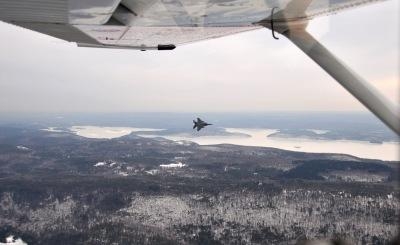Allows NORAD F-16 Pilots To Train For Intercepts
It’s a beautiful day to be flying your Cessna above Maryland’s scenic Eastern Shore, taking in the view of the Chesapeake Bay, when—out of nowhere—an F-16 fighter jet suddenly pulls up beside you because your plane has no business being there ...

Charlie Martinez, Rick Mickerand Robert Bolling know the feeling. Recently the trio—MITRE colleagues and members of Civil Air Patrol’s Congressional Squadron—flew a CAP Cessna 182 (similar CAP aircraft pictured in file photo) to pose as intruders in restricted airspace. In effect, they were targets, giving U.S. Air Force Air Defense F-16 fighter pilots charged with defending Washington, D.C. a chance to practice their intercept procedures.
Martinez and Micker, both of whom have previously participated in F-16 exercises with Civil Air Patrol, sometimes make the pilots work for it. On the most recent exercise, for example, when the F-16 pilot came on the simulated emergency frequency asking the Cessna crew to identify itself, Martinez responded in Spanish, “‘No hablo Ingles; mi piloto esta muerto” (“I don’t speak English; my pilot is dead”).
“About five minutes later, they came on the radio again in Spanish to talk to us,” Martinez said. “And then Rick got back on and said, ‘How’s your French?’ They said, ‘Not so good,’ and we said, ‘OK, we won’t pull that one on you.’”
Watching it all, Bolling—who was taking part in his first F-16 exercise but had flown the fighter jets himself —was impressed with how well the pilots responded. “It looks like they have access to people who can speak multiple languages that they can call upon in these kinds of situations, which is kind of neat,” he said.
CAP is the congressionally chartered, federally supported, non-profit corporation that serves as the official civilian auxiliary of the Air Force. Several CAP wings in the Washington, D.C., area take turns with the F-16 intercepts. Congressional Squadron members generally know a few weeks in advance when it’s their turn. They have a very detailed telephone briefing with the fighter group and the controlling groups in the Air Force and CAP to determine the date and time of the intercept as well as the general location. The volunteer pilots don’t reveal to the fighter pilots what scenarios they will use until the scenario is executed.
For all the detailed discussions beforehand, the exercise itself can still be jarring, even for veterans like Martinez. "Although we knew that we were going to be intercepted, and we knew exactly when we were going to be intercepted, when that airplane pulls up right alongside you, it still gives your heart a thump,” he said.
But more than thrill-seeking motivates Martinez, Micker and Bolling, though all three of them love to fly. They see the exercises—and their CAP work in general—as a patriotic imperative. “My feeling is that I am doing more to help with homeland security than in any other effort that I have done,” Micker said. “I just feel that this is helping the pointy end of the spear.

“Those interceptors—those are the guys that are protecting the National Capital region. Those guys are sitting there in flight suits waiting to launch. And if we can help them improve their efficacy, we’re doing a phenomenal job,” he said.
That spirit applies to the other volunteer opportunities CAP offers. The organization sometimes calls squadrons to help with search and rescue. Micker has taken part in such missions — both exercises and the real thing — in Virginia for overdue planes subsequently identified as having crashed in an area.
Washington, D.C., squadrons have worked with the Maryland Highway Patrol monitoring traffic on the Chesapeake Bay Bridge and advising officials of congestion. CAP also gets involved in disaster recovery — for example, flying more than 1,000 hours during the 2011 oil spill in the Gulf of Mexico.
Meanwhile, the MITRE Civil Air Patrol volunteers are waiting for their next rendezvous with an F-16. Bolling hopes to be on board again. “If I’m available, I absolutely will go,” he said.
And the F-16 pilots might be well-advised to practiquer leur français.
 Sierra Space Repositions Dream Chaser for First Mission
Sierra Space Repositions Dream Chaser for First Mission ANN's Daily Aero-Term (05.10.24): Takeoff Roll
ANN's Daily Aero-Term (05.10.24): Takeoff Roll Aero-News: Quote of the Day (05.10.24)
Aero-News: Quote of the Day (05.10.24) Aero-News: Quote of the Day (05.11.24)
Aero-News: Quote of the Day (05.11.24) ANN's Daily Aero-Term (05.11.24): IDENT Feature
ANN's Daily Aero-Term (05.11.24): IDENT Feature




